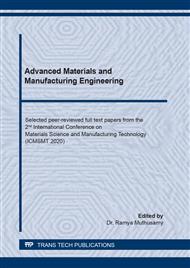p.135
p.145
p.157
p.167
p.174
p.181
p.194
p.205
p.211
Air Assisted Atomization Characterization of Biodegradable Fluid Using Microlubrication Technique
Abstract:
In microlubrication, effective spray cooling is generally dependent on the atomization process. Air assisted atomizer is commonly used in many industrial applications because even at low-pressure fuel or coolant supply, it can create a fine spray formation. Viscosity force resists the deformation of liquid ligaments into a droplet. This increase in viscosity creates a bigger droplet size. If the density of the coolant is more, it will resist the acceleration and results in a bigger droplet. Properties of coolant such as viscosity, density, and surface tension are important and will affect the droplet size. Hence, for effective microlubrication, the performance study of atomization is important. In this paper, computational fluid dynamics (CFD) is used to study atomization characteristics of biodegradable coolant castor oil and AccuLube-2000 at flow rate 150 ml/hr to 60 ml/hr. This paper focuses on the effect of coolant properties like viscosity and density on the droplet size and discrete phase model concentration. In this work, the CFD atomization is studied using a discrete phase model and a Realizable k-ϵ turbulent flow model. Numerical simulation shows that the droplet size of the castor oil is more than AccuLube-2000. Also, for a higher flow rate, the area near the nozzle had a very uneven concentration of sprayed particles. However, the concentration was more even as the spray went farther away from the nozzle.
Info:
Periodical:
Pages:
211-217
Citation:
Online since:
January 2021
Authors:
Keywords:
Price:
Сopyright:
© 2021 Trans Tech Publications Ltd. All Rights Reserved
Share:
Citation:


